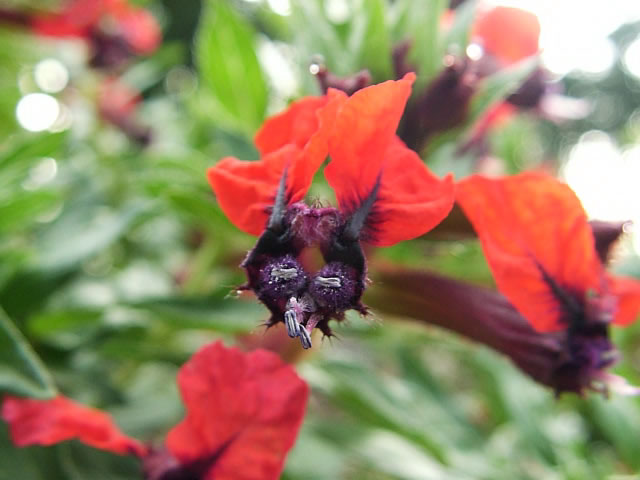The uniquely shaped flowers of the bat faced cuphea (Cuphea llavea) make this tropical plant a must-have for many gardeners. However, these bushy shrubs often fall victim to boring insects that can seriously damage and even kill the plants if left unchecked. Getting rid of borers from your prized bat faced cupheas requires diligence and multiple control methods. But with prompt action, you can protect your plants from these destructive pests.
Identifying Borer Infestations
The first step is learning to recognize the signs of borers on your bat faced cupheas. These include
- Small holes in stems and branches
- Sawdust-like material or sap oozing from holes
- Wilting, dying leaves or branches
- Tunnels visible when peeling back bark
- Swellings or gnarled lumps on branches
Act promptly at the first signs of damage to control borers before they become widespread.
Pruning Out Borer-Infested Areas
Cut away all branches and stems showing borer damage Use sterilized, sharp pruning shears to make clean cuts an inch or more below affected areas Destroy the cuttings immediately to prevent spread. Regular pruning not only removes borers but stimulates new growth. Monitor weekly for reinfestation.
Hunting for Borers
Inspect plants minutely every few days and use a knife to slit stems and expose tunnels. Remove and destroy any borers found inside. Searching diligently for borers and handpicking them out when populations are low can effectively control infestations.
Applying Chemical Controls
For heavy borer infestations, pesticides may be necessary. Insecticides like carbaryl, cyfluthrin, permethrin or spinosad can be sprayed on plants to kill active borers. Systemic insecticides that are absorbed by plants provide longer control. Be sure to read and follow label directions carefully when using pesticides.
Deploying Beneficial Insects
Natural enemies like parasitic wasps, beetles, flies and nematodes prey on borers and are safer options than chemicals. Releasing them onto affected plants allows these beneficials to infiltrate stems and devour borers from the inside out. They provide biological control while causing no harm to your bat faced cupheas.
Using Physical Barriers
Wrapping bat faced cuphea stems with aluminum foil, flexible plastic or burlap can block borers from gaining entry. Leave the tops uncovered to avoid overheating leaves. Re-apply barriers every 2-3 weeks through spring and summer to exclude new adult borers.
Maintaining Plant Health and Vigor
Bat faced cupheas that are stressed or weakened are most susceptible to borer infestations. Ensure plants get adequate sunlight, regular fertilization and sufficient irrigation. Avoid overcrowding and prune off any dead or dying stems that attract borers. Healthy, vigorous plants can better withstand and outgrow borer damage.
Employing Repellent Plants
Certain plants like onions, garlic, chives and mint contain compounds that repel borers. Interplanting these throughout your garden creates a natural barrier to deter borers from your susceptible bat faced cupheas. The strong scents mask attractive plant odors and make it harder for borers to find hosts.
Removing Host Plants
Eliminate any neglected, highly infested plants in or near your garden. Weeds like ragweed, fleabane, goldenrod and aster harbor borer populations and should be removed. Destroying these reservoir hosts lessens borer pressure on your desirable bat faced cuphea plants.
Using Physical Barriers
Floating row covers provide effective exclusion against adult borers in spring when vulnerable new growth appears. Drape the fabric directly over plants and secure the edges with weights. Remove covers when flowers start blooming to allow pollination. Time applications for peak borer activity in your area.
Monitoring for Early Detection
Frequently check bat faced cupheas for borer activity, especially in spring when new leaves emerge. Finding and destroying the first few borers before they multiply prevents major outbreaks later. Setting up pheromone traps also alerts you to increasing borer populations.
Battling borers takes persistence, but incorporating multiple tactics keeps these damaging pests under control. An integrated approach allows you to enjoy borer-free bat faced cupheas and the delightful flowers that make them so prized. With timely prevention and control, your plants can continue gracing your garden with their unique blossoms for years to come.

Regular Reconnaissance: Inspecting Your Plant Allies
Inspect your Bat-faced Cuphea regularly, like a security guard on night watch. Flip leaves and peer into nooks for early signs of pests.
Meet the Usual Suspects: Common Pests on Bat-faced Cuphea
Tiny webs under leaves and a speckled look on foliage scream spider mites.
Blast them with water or apply neem oil. Keep humidity high to deter future invasions.
Look for bumps on stems and leaves—classic scale.
Rub them off with an alcohol swab or apply horticultural oil. Inspect new plants to prevent spread.
How to Remove Squash-Vine Borers
FAQ
What insecticide kills borers?
How do you get rid of borers naturally?
How to care for bat face Cuphea?
How do you grow a bat-faced Cuphea?
Grow bat-faced cuphea in full sun in the ground or in containers. Provide regular moisture, although plants will tolerate dry conditions occasionally. Fertilize plants in containers several times during the summer months. Pinch back or shear if plants become too leggy later in the growing season.
How do you care for a bat faced Cuphea?
For best results, provide plants with: Organic soil. Full sun or part shade, depending on where you live. Regular water. All-purpose fertilizer. Bat-faced cuphea is fairly low maintenance. You can perform some light tip pruning or pinching if plants become too leggy.
What is a bat face Cuphea plant?
Native to Central America and Mexico, bat face cuphea plant (Cuphea llavea) is named for its interesting little bat-faced blooms of deep purple and bright red. Read this article for helpful informatio
Are bat faced Cuphea deer resistant?
It is deer-resistant. Bat-faced cuphea makes a nice container plant, particularly if you need to overwinter it indoors. Many gardeners enjoy this plant in hanging baskets, and some use it as a houseplant year ‘round. Don’t let your container dry out, and make sure the plant gets four hours of bright sunlight each day!
